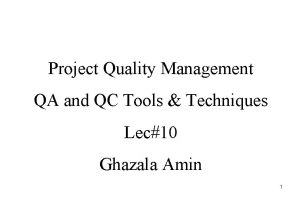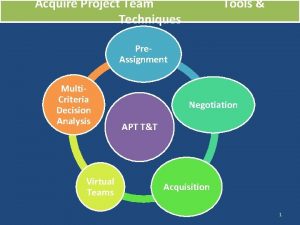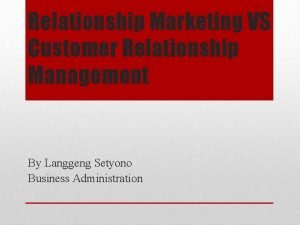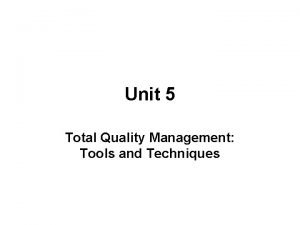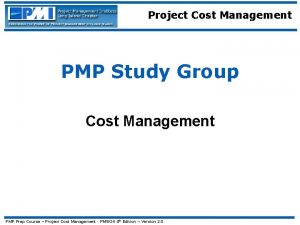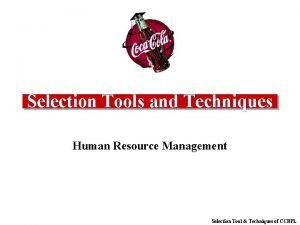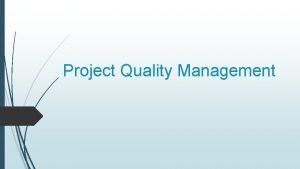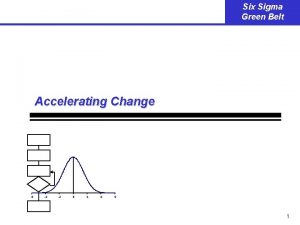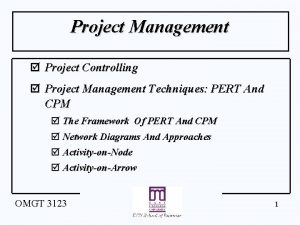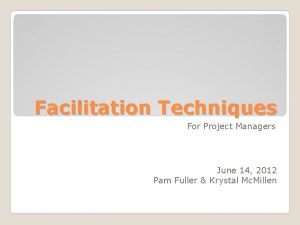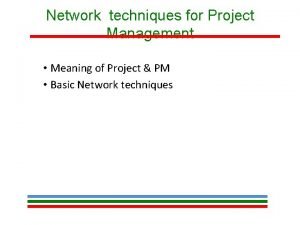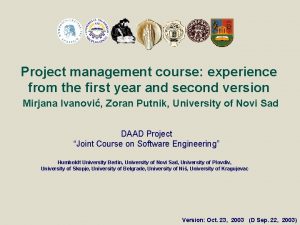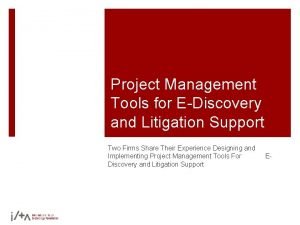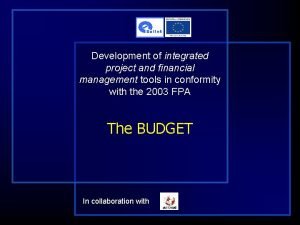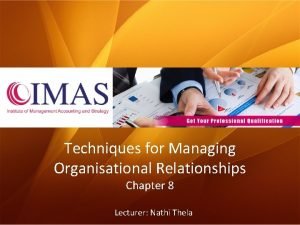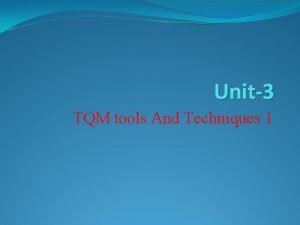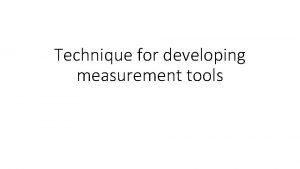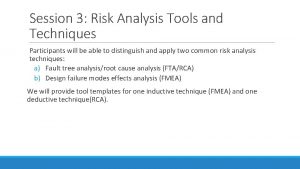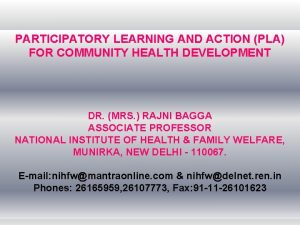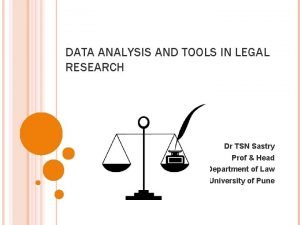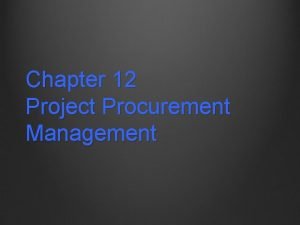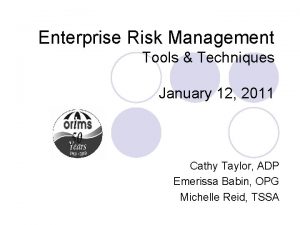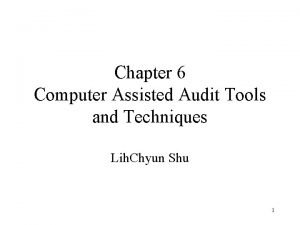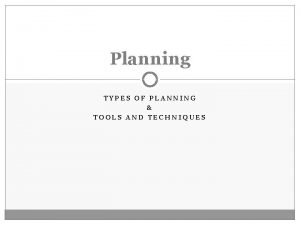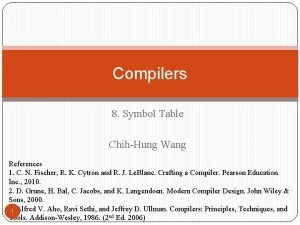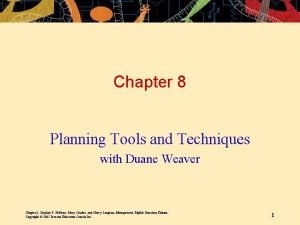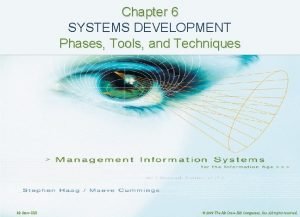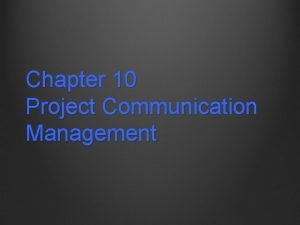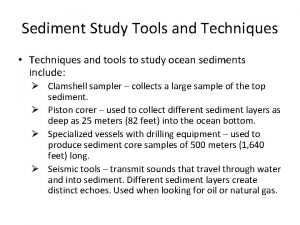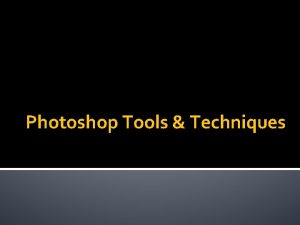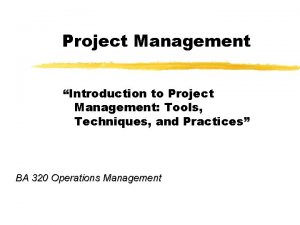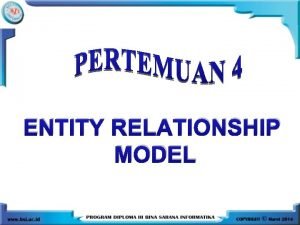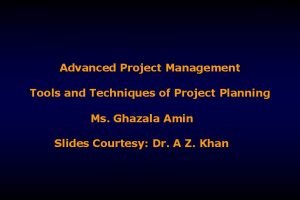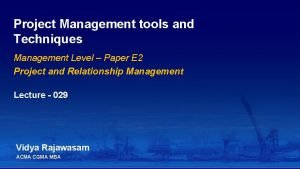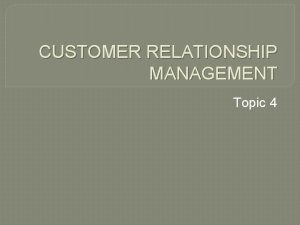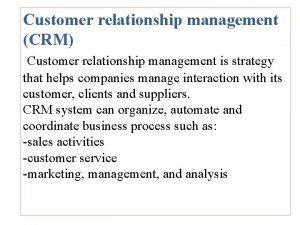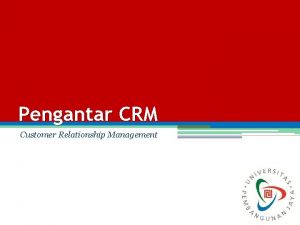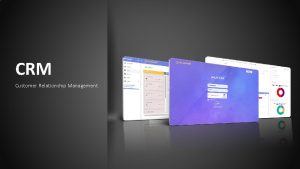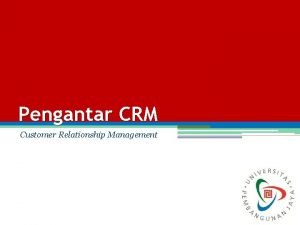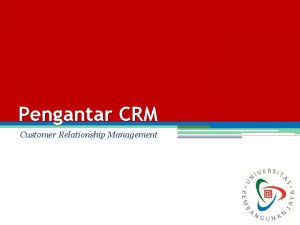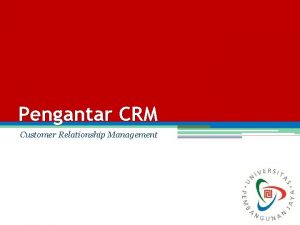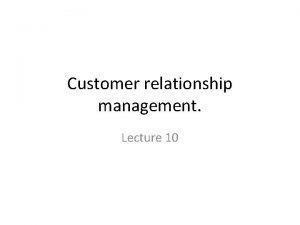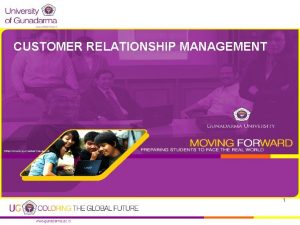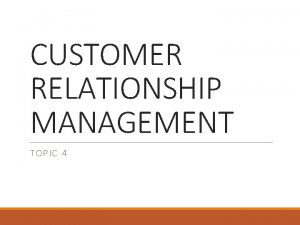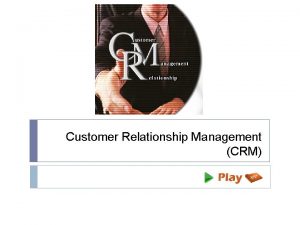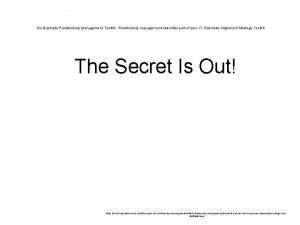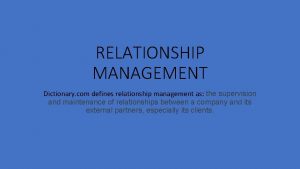E 2 Relationship Management Project Management Tools Techniques

































- Slides: 33

E 2: Relationship Management Project Management Tools & Techniques Lecture 9 Lecturer: Roxanne Mingard and Nathi Thela

1. The Different Purposes of Managing Change. Organisations Through Projects (30%) 1. Discuss concepts involved in managin projects I. Discuss the characteristics of the different phases of a project II. Apply tools and techniques for project managers III. Discuss management and leadership issues associated with projects, including roles of key players in projects

Tools & Techniques Planning Activities - Breakdown Structures: – Work Breakdown Structure (WBS) – Work Packages (WPs) – Statements of Work (SOWs) – Product Breakdown Structure (PBS) – Cost Breakdown Structure (CBS) Lecturer: Roxanne Mingard 3

Work Breakdown & Work Package Structure Work Breakdown Structures: • Breaks complex tasks into pieces • Sets out logical sequence of events • Provides logical framework for decisions • Provides an input into subsequent project processes (Approx. time & resources) • Provides framework for continuous assessment of project progression • Provides communication tool Lecturer: Roxanne Mingard Work Package & Statement of Work: • Specifies work to be done for each package • SOW describes deliverables and measurements for success • Identify detail of work to be done & standard • SOW indicates responsibility & timing 4

Product Breakdown & Cost Breakdown Structure Product Breakdown Structure: • Products required for each activity • Description of machinery/equipment required Cost Breakdown Structure: • Information gathered in WBS, SOW, WP, PBS and cost benefit analysis. • Specifies categories requiring costing • Allocation of costs across the project • Forms financial plan & budget. Benefits of breakdown structures 1. Summarise activities 2. Displaying interrelationships of tasks 3. Establishing authority & responsibility 4. Estimating project cost 5. Performing risk analysis 6. Scheduling jobs 7. Basis for controlling application of resources Lecturer: Roxanne Mingard 5

Planning for Quality Project Quality Plan - Document which details Standards to be adhered to to ensure successful development process. Indicates policies and procedures to be adhered to to maintain quality. Includes: • Project overview • Project Requirements • Project Organisation • Monitoring & reporting procedures • Key Development stages & processes • Key standards to be used • Risk Assessment • Testing strategy • Procurement policy • Configuration management Lecturer: Roxanne Mingard 6

Planning for Time Network Analysis – analysis of interrelationships between tasks. Consists of critical path analysis (CPA): CPA used for: 1. Analyse project 2. Draw out Network Diagram 3. Estimate time and costs of each activity 4. Locate critical path 5. Schedule project 6. Monitor & control progress 7. Revise plan Rules for diagram drawing: • No loops • Every activity represented only once Lecturer: Roxanne Mingard CPA Notation Reference EET 1 LET EET = Earliest Event (Start) Time for the Next Activity LET = Latest Event (Start) Time for the Next Activity Float – difference between EET and LET Critical Path – Activities where EET = LET Activity Critical Activity 7

CPA Example Question: List of project activities below. Identify critical path, estimated project duration and any float on any activity Lecturer: Roxanne Mingard 8

Critical Path Analysis Network Diagram 1 A 0 2 0 B 8 4 8 8 C 10 18 18 E 5 8 26 26 D 6 4 3 Lecturer: Roxanne Mingard 6 Critical Path: ABE Est. Duration: 26 Float on C or D of 8 14 9

CPA Limits & Benefits Limitations: • Time consuming to produce and monitor for large projects • Difficult to use for less routine projects with lots of uncertainty • Overly complex for smaller short-term projects Benefits: • Assist in identifying all activities required • Identifies parallel activities and dependent activities with activities pre-ceding them • Identify activities on critical path and those with float/buffer • Show minimum completion time for project & allow for sensitivity analysis to be introduced Lecturer: Roxanne Mingard 10

Planning For Resources Resource Histogram Identifies in block graph the fluctuating need (amount & timing) for finance, staff, technology, vendor services at any stage. Benefits: • Capacity Planning, resource scheduling • Visually represents resource allocation • Drawn in real time Lecturer: Roxanne Mingard 11

Project Management Software • • Planning – creates network diagrams, Gantt charts, PID, PQP, WBS Estimating – resource allocations, budgets, allocation of time across tasks Monitoring – network all team members, store for all project documentation, variance analysis Reporting – technical documents, reports Advantages: • Improved planning & control • Improved communication • Improved quality of systems developed • Accuracy • Ability to handle complexity • Scenario planning & ease of variance analysis & changes • Timesheet recording Lecturer: Roxanne Mingard Inclusions: • Budgeting & cost control • Calendars • Graphics • Multiple project handling • Planning • Scheduling • Resource planning • Resource histogram 12

Project Management Methodologies – set of guidelines which defines methods & processes to be followed for successful project delivery Benefits: • Step by step approach • Stages in methodology become familiar – speed up completion • Keeps project on track & identify deviations • Ability to compare projects • Familiarities improves project management & communication • Methodology developed over time resulting in best practice approach Limitations: • If methodology unsuitable, may make managing projects challenging • No one methodology suits all projects Lecturer: Roxanne Mingard 13

PMBOK vs PRINCE 2 Lecturer: Roxanne Mingard 14

Projects In Controlled Environment Version 2 – PRINCE 2 Corporate or Programme Management Project Mandate Starting Up a Project Directing a Project Initiating a Project Controlling a Stage Managing Stage Boundaries Closing a Project Managing Product Delivery Planning Lecturer: Roxanne Mingard 15

PRINCE 2 Structure Project Committee Project Assurance Team: Business Assurance Coordinator User Assurance Coordinator Specialist Assurance Coordinator Senior User Senior Supplier Executive Project Manager Stage Team Leader Project Support

Project Management Body of Knowledge - PMBOK Lecturer: Roxanne Mingard 17

Project Failure 1. Poor leadership 2. Emphasis on maintaining plan rather than managing project 3. Resources inadequate or not managed effectively 4. Poor estimates 5. Inadequate skills 6. Work breakdown not aligned to way of working or skill set of individuals Lecturer: Roxanne Mingard 18

Risk & Uncertainty - PERT Project Evaluation & Review Technique (PERT) Used to identify uncertainties regarding time taken for individual activities. Each task assigned: • Optimistic time - o • Probable time - m • Pessimistic time - p Expected time for each activity - Other risk & Uncertainty Tools: 1. Scenario Planning – considering 1 or more circumstances which may occur 2. Buffering – adding artificial slack 3. Gantt Chart – Horizontal bar chart. Length of bar represents length of activity 1. Milestones represented as triangles on Grantt chart 2. Key Milestones (control gates) – reflect review requirement. Lecturer: decision Roxanneor. Mingard Advantages: • Gives expected completion time • Gives probability of completion before date • Gives slack through earliest and latest start times • Allows calculation contingency to be added to plan Limitations: • Subjective activity times • Assumes probablity distribution of project completion time as critical path 19

Gantt Chart Activity A Current Time 16 A B C D E E 0 4 8 12 16 20 Time Lecturer: Roxanne Mingard Benefits: • Identify all activities • Identify critical activities • Shows min completion time • Visually easier • Shows Actual time vs budget • Aids resource allocation Limitations • Not identify weak links • Does not reveal problems in delays • Does not show degrees of completion 20

Test Your Knowledge Stakeholders ?

E 2: Relationship Management People & Projects Lecture 10 Lecturer: Roxanne Mingard and Nathi Thela

1. The Different Purposes of Managing Change. Organisations Through Projects (30%) 1. Discuss concepts involved in managin projects I. Discuss the characteristics of the different phases of a project II. Apply tools and techniques for project managers III. Discuss management and leadership issues associated with projects, including roles of key players in projects

Stakeholder Hierarchy Project Sponsor – Provides Resources for Project Owner – Interested in End Result Being Achieved Project Brief, Allocation of Funds, Terms of Reference Project Customer – The Customer/User is the End User Project Proposals, Schedules, Status Reports Project Manager – Responsible for Overall Project Output Project Team – Responsible for achieving Project Tasks Purpose of Hierarchy 1. To create a structure of authority so everyone knows who respective decision maker is 24 2. Lecturer: To create. Roxanne series of. Mingard superior-subordinate relationships – everyone has 1 line manager

Stakeholder Hierarchy Project Sponsor: • Initiates project • Appoints project manager • Approval decisions • Provides resources • Monitors progress • Provides support & senior management commitment Project Owner • Person for whom project is being carried out • Concerned with scope, functionality & end result • Senior member of steering committee Project Customer/User: • Same interest as owner – representatives within team or represented by Lecturer: owner. Roxanne Mingard Project Manager Role: • Achieving objectives Resource allocation • Planning, monitoring, controlling • Selecting, building, driving team • Point of contact • Communication Selecting subcontractors • Termination PM Requirements N - Negotiation P – Planning & Control T – Technical Awareness P – People skills (motivation) F – Financial Awareness P – Problem Solving C – Communication C – Change Management D – Delegation L – Leadership Project Team: • Consists of project manager, and specialists assigned or recruited for project. • Team will go through Tuckman’s stages of group development Project Steering committee: • Overseeing project & making high level decisions • Report to project board • Chaired by project sponsor 25

Stakeholder Management & Conflict Once Identified Stakeholders can be mapped: 1. Likelihood of stakeholder group attempting to impress expectations on others 2. Power and means for them to do so 3. Impact of stakeholder expectations on project Causes of conflict: • Unclear objectives • Role ambiguity • Unclear schedules • Low level of authority given to project manager • Remote functional groups within the project • Interference from local & functional management • Personality clashes Lecturer: Roxanne Mingard Techniques for managing conflict: • Negotiation • Mediation • Partnering • Compromise 26

Skills required by a project manager Lecturer: Roxanne Mingard 27

Project Team Lifecycle Performing Storming Norming Adjourning Forming Lecturer: Roxanne Mingard 28

Managing, Leading & Motivating Teams Project team considerations: • Each project is complete entity, unique requirements, experiences, problems, constraints and objectives • Members of team not worked together previously as group • Management style must be appropriate for organisation, team & project – foster an environment of motivation: • Team made up of correct people (Belbin’s model) • Adequate Knowledge & experience in team • Participative style of management • Encouraging participation in decision making • Delegating decisions – encourage ownership & involvement • Regular project meetings • Regular one on one meetings • Ensure clarity of roles & responsibilities – minimize conflict. Lecturer: Roxanne Mingard 29

Belbin’s Team Roles Leader Shaper Finisher Plant Team Roles - Belbin Team worker Company worker Resource Investigator Monitor Evaluator Expert – used when needed (added later) Lecturer: Roxanne Mingard 30

Belbin’s Team Roles Character Types Co-ordinator Shaper Plant Monitor Evaluator Resource Instigator implementer Teamworker Complete Finisher Specialist Lecturer: Roxanne Mingard Role Mature & Confident. Ensures team focuses on objectives. Delegates well Challenging & dynamic. Provides drive to keep team moving. Promotes activity Thoughtful and creative. Generates orginal ideas Logical and analytical. Evaluates options in an impartial manner Enthusiastic & inquisitive. Find ideas from outside and bring to team Practical & reliable. Deals with planning & scheduling. Drives efficiency Co-operative & diplomatic. Concerned with relationships with team/ Diffuses conflict Anxious & conscientious. Scrutinises work for errors. Quality control Single-minded and dedicated. Brings in-depth specialist knowledge to solve technical problems 31

Matrix Structure For Projects Most suitable project structure when: • Business consists of a series of projects • Projects have different start and end dates • Projects are complex • Projects are expensive • Projects are customer facing Advantages Impact on Project Achievement: Disadvantages Lack of clear responsbility Improved decision making – accessibility of wide rangeof skills Conflicting priorities - function vs product Replacement of formal control by direct contact Loss of control of psychological contract Assists in development of managers by exposing Project managers reluctant to impose authority them to company wide problems, understandings & since they may be subordinates in subsequent decisions project Improves lateral communication Lecturer: Roxanne Mingard Appraisal challenges Career development stymied Confusing reporting lines Lots of meetings 32

Test Your Knowledge Stakeholders ?
 Quality control tools and techniques in project management
Quality control tools and techniques in project management Project team assignments
Project team assignments Importance of relationship marketing
Importance of relationship marketing Total quality tools
Total quality tools Estimate costs process
Estimate costs process Human resource management tools and techniques
Human resource management tools and techniques Quality management tools
Quality management tools Strategic plan is
Strategic plan is Change management tools and techniques
Change management tools and techniques Introduction to software project management
Introduction to software project management Risk mitigation techniques in project management
Risk mitigation techniques in project management Pert metoda
Pert metoda Facilitation techniques in project management
Facilitation techniques in project management Network techniques in project management
Network techniques in project management Project management tools in software engineering
Project management tools in software engineering Project cycle management
Project cycle management Project management tools for ediscovery and litigation
Project management tools for ediscovery and litigation Project financial management tools
Project financial management tools Mainwaring conflict management
Mainwaring conflict management Fonction technique scooter
Fonction technique scooter Types of fmea in tqm
Types of fmea in tqm Technique of developing measurement tools involves
Technique of developing measurement tools involves Software quality assurance tools and techniques
Software quality assurance tools and techniques Risk analysis tools and techniques
Risk analysis tools and techniques Participatory learning and action
Participatory learning and action Discuss the importance of data in a legal research.
Discuss the importance of data in a legal research. Procurement project management
Procurement project management Erm tools and techniques
Erm tools and techniques It audit tools and techniques
It audit tools and techniques Planning tools and techniques
Planning tools and techniques Symbol table implementation in lex and yacc
Symbol table implementation in lex and yacc Planning techniques and tools
Planning techniques and tools System development tools and techniques
System development tools and techniques Monitor communications process tools and techniques
Monitor communications process tools and techniques
